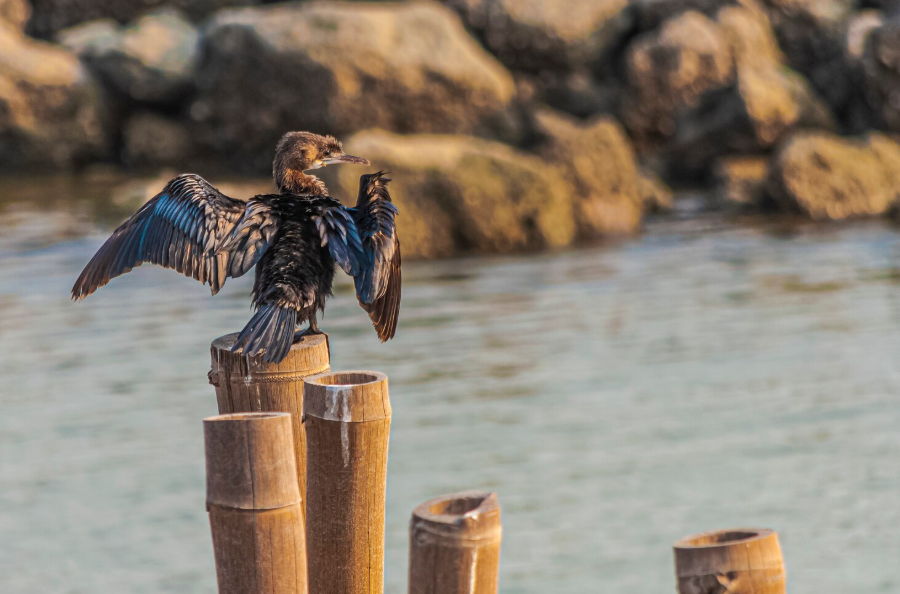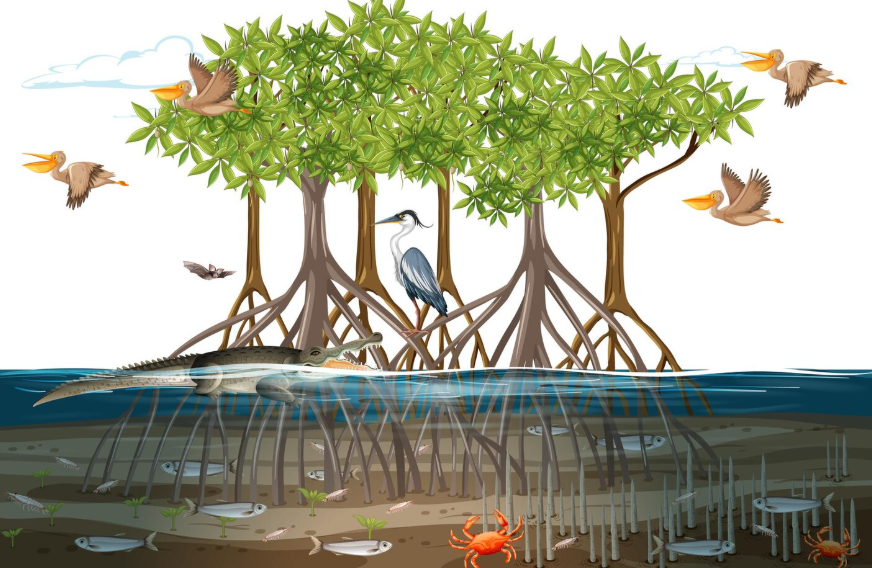Business
Mangroves: Nature’s Guardians of the Coastlines

Mangroves re unique trees and shrubs that grow in coastal intertidal zones in tropical and subtropical regions. They thrive where few plants can survive—salty, muddy environments that are flooded by tides. Unlike most plants, mangroves have specialized roots and salt-filtering capabilities, allowing them to grow at the edge of land and sea, often forming dense forests in estuaries, deltas, lagoons, and shorelines.
Types of Mangroves
There are more than 70 species of mangrove trees found globally, but they are commonly grouped into three main types based on their location and structure: red mangroves (Rhizophora), black mangroves (Avicennia), and white mangroves (Laguncularia). Red mangroves are known for their large, above-ground prop roots. Black mangroves grow pneumatophores—vertical root projections for air exchange. White mangroves typically grow inland and have salt-excreting glands on their leaves.
Unique Adaptations of Mangroves
Mangroves are biologically adapted to survive in extreme environments. Their roots allow them to anchor in soft, unstable soil while resisting tidal currents. Many species use vivipary, where seeds germinate while still attached to the parent tree, allowing rapid rooting upon falling into the mud. Salt exclusion at the root level or excretion through leaves is another evolutionary adaptation, ensuring the plant maintains its internal salt balance.
Mangroves and Biodiversity
Mangrove forests are biodiversity hotspots. They provide shelter, breeding grounds, and nursery habitats for thousands of species, including fish, shrimp, crabs, mollusks, and even birds and reptiles. Many commercially important fish species spend the early stages of their life in mangroves. Animals like mudskippers, mangrove snakes, herons, and proboscis monkeys are adapted to this ecosystem, making mangroves vital for ecological balance.
Role in Coastal Protection
Mangroves act as natural barriers against coastal erosion, storm surges, and tsunamis. Their thick roots stabilize coastlines and reduce the speed and impact of tidal waves. During natural disasters like cyclones and hurricanes, mangrove belts absorb wave energy, protecting inland areas. Studies after the 2004 Indian Ocean tsunami showed that villages shielded by mangroves faced significantly less destruction than those without them.
Carbon Storage and Climate Change
Mangroves are one of the most carbon-rich forests in the world. They store carbon in their biomass and especially in the peat-rich soil beneath them, a process known as “blue carbon” sequestration. Unlike many terrestrial forests, the carbon stored in mangroves can remain locked away for centuries if left undisturbed. Destroying mangroves not only halts this sequestration but also releases large amounts of stored carbon, contributing to climate change.
Mangroves and Livelihoods
Millions of people around the world depend on mangrove ecosystems for their livelihoods. Coastal communities harvest fish, shrimp, honey, and medicinal plants from mangrove forests. In places like Southeast Asia and West Africa, mangroves support local economies through fisheries and sustainable wood harvesting. Eco-tourism in mangrove areas is also a growing source of income, offering activities such as boat rides, bird watching, and kayaking.
Mangrove Degradation and Threats
Despite their ecological and economic value, mangroves are under threat globally. Over the past few decades, vast areas have been cleared for shrimp farming, aquaculture, agriculture, urban expansion, and tourism infrastructure. Pollution, damming of rivers, oil spills, and rising sea levels further threaten these forests. According to the IUCN, more than one-third of the world’s mangroves have been lost since the 1980s.
Mangrove Conservation Efforts
Efforts to protect and restore mangroves are gaining momentum. Governments, NGOs, and local communities are working together to reforest degraded areas and enforce protection laws. For example, India, Indonesia, and the Philippines have launched large-scale mangrove reforestation projects. Innovative methods like drone seeding, community participation, and blue carbon credits are being used to ensure sustainable restoration and management.
Mangroves in India
India has one of the largest mangrove covers in the world, with Sundarbans being the most famous. Located in West Bengal, the Sundarbans is a UNESCO World Heritage Site and the largest tidal halophytic mangrove forest in the world. It’s home to the endangered Royal Bengal Tiger and a wide range of aquatic species. Other important mangrove regions in India include the Bhitarkanika in Odisha, Pichavaram in Tamil Nadu, and the Gulf of Kutch in Gujarat.
Educational Importance of Mangroves
Mangroves offer unique opportunities for environmental education and awareness. Field trips to mangrove areas help students understand ecology, climate change, and sustainable development. Research institutions often study mangroves to understand coastal dynamics, biodiversity, and ecosystem services. They act as living laboratories where the relationship between humans and nature can be practically understood and observed.
Mangroves and International Agreements
The importance of mangroves is recognized by international agreements like the Ramsar Convention on Wetlands and the UN Sustainable Development Goals (SDGs). The SDGs aim to halt deforestation, promote biodiversity, and increase climate resilience—goals that align directly with mangrove conservation. Many mangrove areas are now protected under these frameworks, offering a legal mechanism for long-term protection and funding.
Ecotourism in Mangrove Regions
Ecotourism in mangrove zones is gaining popularity due to the rich experience they offer. Visitors enjoy bird watching, nature photography, and exploring biodiversity via boat safaris through water channels. Countries like Thailand, Malaysia, and Sri Lanka have successfully promoted mangrove tourism as part of their sustainable tourism initiatives. This provides revenue while also spreading awareness about conservation.
Technology in Mangrove Restoration

Modern technology is playing a key role in mangrove conservation. Satellite imaging and GIS tools are used to monitor mangrove coverage and identify areas of degradation. Drones are being deployed to plant mangrove seeds over large areas efficiently. AI and data analytics help predict areas vulnerable to erosion or sea-level rise, making restoration efforts more targeted and impactful.
The Future of Mangroves
The survival of mangroves depends on human action. With increasing climate awareness, the global community is now recognizing mangroves as frontline defenders against environmental threats. Their restoration not only ensures biodiversity and food security but also contributes to achieving carbon neutrality. Investing in mangroves is not just about planting trees—it’s about securing coastlines, communities, and climate stability.
Conclusion
Mangroves are more than just trees by the sea—they are ecological powerhouses, cultural icons, and economic lifelines. They protect us from the worst impacts of nature while nurturing some of its most delicate life forms. In an age of climate crisis and environmental degradation, mangroves stand as a symbol of resilience, balance, and hope. Saving them is not just a scientific duty but a moral responsibility for every global citizen.
-

 Tech12 months ago
Tech12 months agoHow to Use a Temporary Number for WhatsApp
-

 Business2 years ago
Business2 years agoSepatuindonesia.com | Best Online Store in Indonesia
-

 Social Media1 year ago
Social Media1 year agoThe Best Methods to Download TikTok Videos Using SnapTik
-

 Technology1 year ago
Technology1 year agoTop High Paying Affiliate Programs
-

 Tech7 months ago
Tech7 months agoUnderstanding thejavasea.me Leaks Aio-TLP: A Comprehensive Guide
-

 Instagram3 years ago
Instagram3 years agoFree Instagram Auto Follower Without Login
-

 Instagram3 years ago
Instagram3 years agoFree Instagram Follower Without Login
-

 Technology11 months ago
Technology11 months agoLeverage Background Removal Tools to Create Eye-catching Videos


















